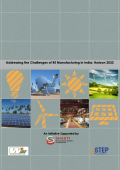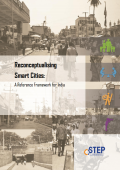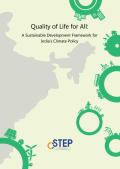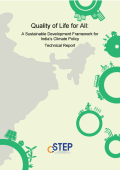
This study comprehensively examines the manufacturing supply chain of different components used in RE (renewable energy) systems, especially wind and solar technology, in India. Over the past one and half years, around 90 interviews were conducted across the solar and wind industry comprising manufacturers, developers, system integrators, academicians and policy makers. A sourcing strategy for these components has been identified based on macroeconomic criteria, material and resource constraints, techno-economic feasibility and international market dynamics. The report also proposes necessary policy and regulatory interventions to expand the supply of RE and create a demand-side pull.

The Government of India (GoI) initiated the "100 Smart Cities Mission" in 2014. This has triggered deliberations across the country on the concept of smart cities, the need and the orientation of the Mission in the context of India’s present urbanisation scenario. The concept of a "Smart City" is a relatively new phenomenon in India. This report is a step towards synthesising various aspects related to smart cities that has led to the formation of a proposed Reference Framework by CSTEP, for the Smart Cities Mission in India. The report is expected to guide policy makers and urban practitioners in making critical decisions, in an accountable manner and spirit, which will truly make Indian cities smart.
The report begins by carving out the following scope, for India:

India and other countries are expected to submit their Intended Nationally Determined Contributions (INDCs) for the Conference of Parties (COP-21) in December 2015. Keeping in mind the expectation that India will experience severe impacts from global warming and the fact that a large proportion of people still require basic needs and energy services, CSTEP conducted a study examining two scenarios for India’s development by 2030: policy or Business as Usual (BAU) and Sustainable Development (SD) or quality of life.
The study builds on the India Energy Security Scenarios (IESS) 2047 tool developed by NITI Aayog by adding a ‘quality of life’ dimension to the energy and emissions pathways.

India and other countries are expected to submit their Intended Nationally Determined Contributions (INDCs) for the Conference of Parties (COP-21) in December 2015. Keeping in mind the expectation that India will experience severe impacts from global warming and the fact that a large proportion of people still require basic needs and energy services, CSTEP conducted a study examining two scenarios for India’s development by 2030: policy or Business as Usual (BAU) and Sustainable Development (SD) or quality of life. The study builds on the India Energy Security Scenarios (IESS) 2047 tool developed by NITI Aayog by adding a ‘quality of life’ dimension to the energy and emissions pathways.

This report compares Green Public Procurement (GPP) programs from four leading Asian countries (China, Japan, Korea and Thailand) to understand what the frameworks and key success factors that result in high-impact green and sustainable procurement are. It looks at their commonalities and differences with the goal of informing a more effective implementation of green procurement policies and programs across Asia. It will be beneficial for other countries in the early stages of promoting and implementing green public procurement, and it will give practitioners insights into the tools and approaches used to implement and promote it.
